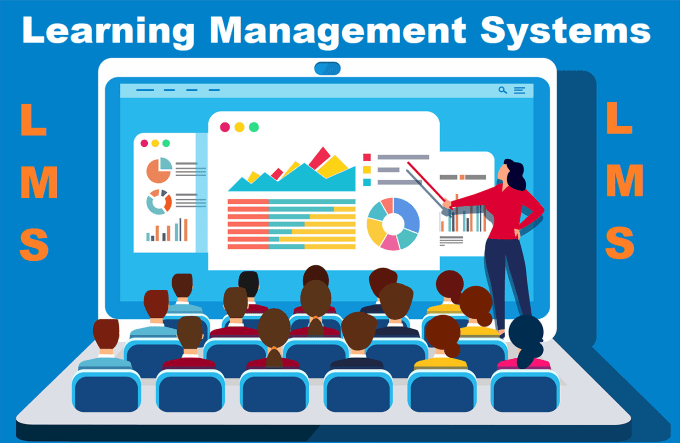In the digital age, Learning Management Systems (LMS) have become essential for educational institutions and businesses alike. They provide a platform for delivering, tracking, and managing educational courses and training programs. Whether you’re creating an LMS for schools, corporate training, or e-learning, building a comprehensive system requires careful planning and execution. In this guide, we’ll explore the steps to build an effective LMS website and app.

Table of Contents
Toggle1. Define Your Goals and Target Audience
Before starting the development process, clearly define the objectives of your LMS and identify your target audience. Consider the following:
- Target Users: Are you catering to schools, universities, corporate training programs, or independent learners?
- Learning Objectives: What are the key outcomes you want to achieve (e.g., skill development, compliance training, certification)?
- Content Type: Determine the types of content you will offer, such as video lessons, quizzes, assignments, or interactive modules.
2. Outline Features and Functionality
An effective LMS should provide a variety of features for both learners and administrators. Here’s a list of essential functionalities:
User Features
- User Registration and Profiles: Allow users to create accounts and set up profiles with personal information, progress tracking, and achievements.
- Course Catalog: Provide a searchable catalog of available courses with detailed descriptions, prerequisites, and enrollment options.
- Interactive Content: Support various content types, including videos, PDFs, quizzes, and discussion forums.
- Progress Tracking: Enable users to track their progress, completion rates, and performance metrics.
- Certificates and Badges: Offer certificates or badges upon course completion to motivate learners.
Admin Features
- Course Management: Allow administrators to create, edit, and manage courses, including content uploads and scheduling.
- User Management: Enable admins to manage user accounts, track engagement, and oversee progress.
- Reporting and Analytics: Provide insights into user performance, course effectiveness, and overall engagement metrics.
- Communication Tools: Implement messaging systems or discussion boards to facilitate communication between learners and instructors.
3. Choose the Right Technology Stack
Selecting the right technology stack is crucial for building a scalable and efficient LMS. Consider the following components:
- Frontend Development: Use frameworks like React, Angular, or Vue.js for building responsive web interfaces and mobile applications.
- Backend Development: Opt for languages and frameworks such as Node.js, Django, or Ruby on Rails for server-side development.
- Database: Use databases like PostgreSQL, MySQL, or MongoDB for data storage and management.
- Hosting: Choose a reliable hosting provider or cloud service (like AWS, Google Cloud, or Azure) to ensure scalability and performance.
4. Design the User Interface (UI) and User Experience (UX)
Creating an intuitive and user-friendly interface is essential for engaging users. Here are some design considerations:
- Consistent Branding: Develop a cohesive brand identity, including logos, color schemes, and typography, that resonates with your target audience.
- Simple Navigation: Ensure easy navigation throughout the platform, allowing users to find courses and resources quickly.
- Mobile Responsiveness: Design for mobile devices to ensure learners can access content anytime, anywhere.
- Accessibility: Implement accessibility features to accommodate users with disabilities, ensuring a more inclusive learning experience.
5. Develop the LMS Website and App
With your features, technology stack, and design in place, it’s time to start development. Consider the following best practices:
- Agile Development: Use agile methodologies to allow for flexibility and iterative improvements during the development process.
- Version Control: Implement version control systems like Git to manage code changes and collaborate with your development team.
- Testing: Conduct thorough testing throughout the development process, including unit testing, integration testing, and user acceptance testing to ensure a bug-free experience.
6. Implement Course Creation Tools
To attract educators and trainers to your platform, provide them with easy-to-use course creation tools. These should include:
- Content Upload: Allow instructors to upload videos, documents, and other resources seamlessly.
- Course Structuring: Enable educators to create course outlines, modules, and assessments.
- Interactive Features: Incorporate tools for creating quizzes, assignments, and discussion forums to foster engagement.
7. Integrate Payment Processing
If you plan to charge for courses, integrate secure payment processing options. Consider popular payment gateways like:
- Stripe
- PayPal
- Square
Ensure that the payment process is seamless and secure, providing users with multiple payment options.
8. Launch and Market Your LMS
Once your LMS is developed, it’s time to launch and attract users. Consider the following marketing strategies:
- SEO Optimization: Optimize your website for search engines to improve visibility and attract organic traffic.
- Social Media Marketing: Leverage platforms like Facebook, LinkedIn, and Instagram to promote your courses and engage with potential users.
- Content Marketing: Create valuable content (e.g., blog posts, webinars, and tutorials) that showcases your expertise and draws users to your platform.
- Email Campaigns: Use email marketing to reach potential users, promote new courses, and keep current users engaged.
9. Monitor and Improve
After launching your LMS, continuously monitor its performance and gather user feedback. Utilize analytics tools to track user behavior, course engagement, and overall platform usage. Based on this data, make informed decisions about feature enhancements, bug fixes, and marketing strategies.
Conclusion
Building a Learning Management System (LMS) website and app can significantly enhance the educational experience for learners and educators alike. By defining your goals, outlining essential features, choosing the right technology stack, and implementing effective marketing strategies, you can create a successful platform that meets the needs of your audience. As you embark on this journey, prioritize user experience and stay adaptable to market changes to ensure the long-term success of your LMS. Happy building!


No responses yet